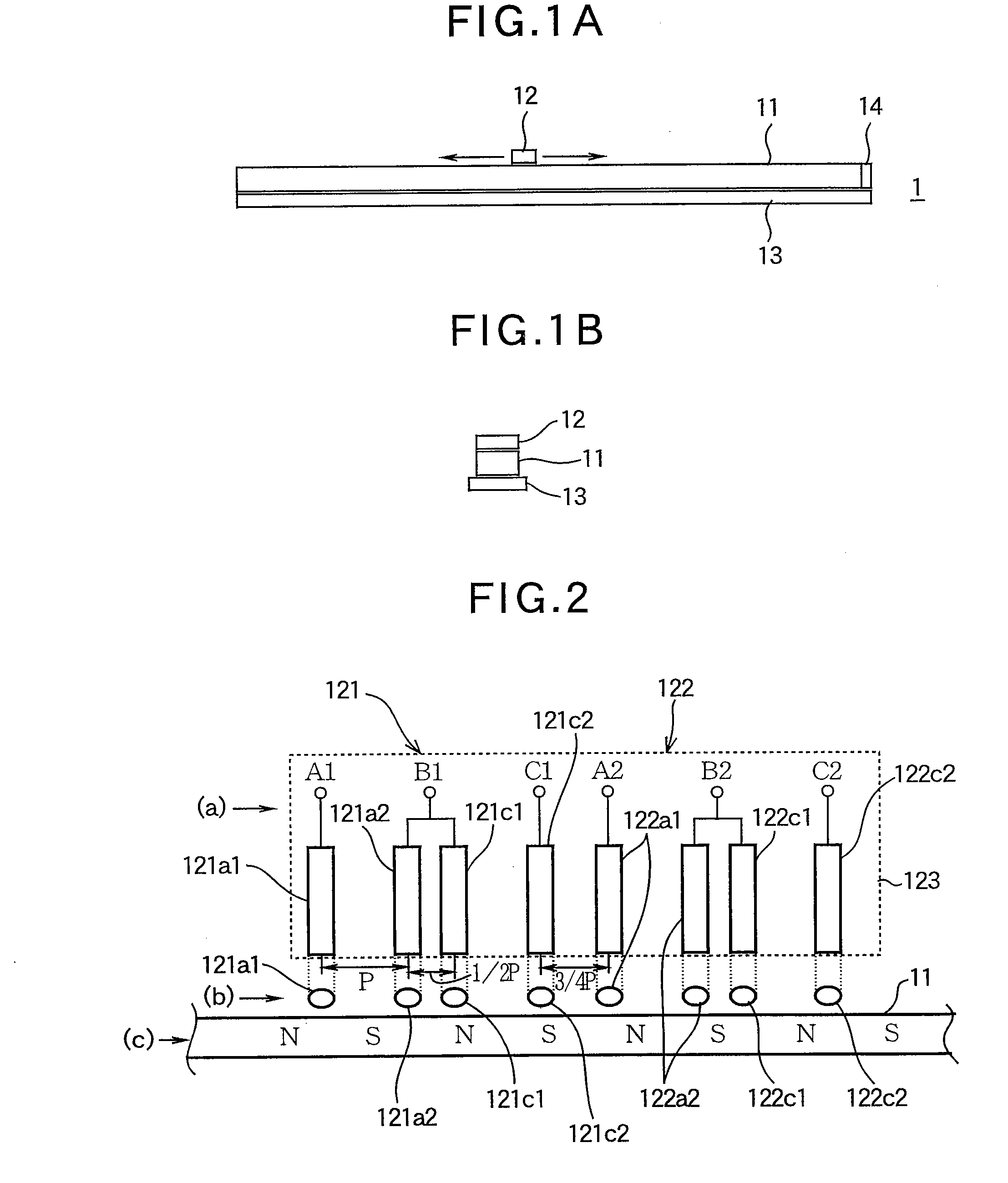Position Detector
a position detector and detector technology, applied in the field of position detectors, can solve the problems of reducing the sliding ability, increasing the cost of positioning detectors, and increasing the number of appliances using position detectors, so as to reduce the width of the track, increase the magnetic field, and reduce the magnetic flux
- Summary
- Abstract
- Description
- Claims
- Application Information
AI Technical Summary
Benefits of technology
Problems solved by technology
Method used
Image
Examples
first embodiment
[0053]FIGS. 1A and 1B are schematic side views illustrating a basic configuration of a position detector (magnetic scale) 1 according to the invention. Specifically, FIG. 1A is a longitudinal side view of the magnetic scale 1 and FIG. 1B is a transversal side view of the magnetic scale 1.
[0054]The magnetic scale 1 includes a magnetic scale member (magnetic scale part) 11, a magnetic sensor (magnetic detection part) 12, and a magnetic field shaping member (magnetic field shaping part) 13.
[0055]For example, the scale member 11 is a bar-shaped member formed of a permanent magnet such as a ferrite magnet including a metal compound or a rubber magnet formed by mixing ferrite magnetic powder, rubber material, etc. The scale member 11 may also be formed by filling a groove in a stainless bar (for example, having a radius of 4.0 to 8.0 mm) with a long and thin rubber magnetic filler (for example, having a radius of 1.5 to 5.0 mm) and then magnetizing the magnetic filler from a top 11a, usin...
third embodiment
[0084]FIG. 9 is a schematic plan view illustrating a basic configuration of a position detector (magnetic scale) 2 according to the invention.
[0085]This embodiment differs from the first embodiment in that a magnetic field shaping member 23 formed of a permanent magnet is disposed near an end portion of the scale member 11 instead of disposing the magnetic field shaping member 13 throughout the entire length of the scale member 11. Other aspects of the basic configuration of the magnetic scale are similar to those of the first embodiment and thus a description thereof is omitted herein.
[0086]In the position detector (magnetic scale) 2 according to the third embodiment, it is necessary to perform a process for extracting an origin forming signal since the magnetic field shaping member 23 is mounted only at the end portion of the scale member as described above. Therefore, a scale signal A and an origin forming signal B are XORed as shown in FIG. 10 and an XOR signal initially output ...
fourth embodiment
[0087]As shown in a timing chart of FIG. 10, as the magnetic sensor 12 is moved toward the end portion of the scale member 11, origin forming signals disappear upon entering a specific section, and an origin forming signal B that is first detected after origin forming signals disappear can be determined to be a genuine origin forming signal, provided that a plurality of scale signals is present in the specific section where no origin forming signal is present. Processes in this case will be described below in the invention. A right end portion of the signal A in FIG. 10 is disregarded since it corresponds to a right end portion of the analog signal in FIG. 6 and a right end portion of the signal A based on the analog signal in FIG. 6 while it represents an inaccurately magnetized portion of the end portion of the scale member 11.
[0088]FIG. 11 is an exploded perspective view of a main part of a slide volume device 3 according to the fourth embodiment of the invention. Components simi...
PUM
 Login to View More
Login to View More Abstract
Description
Claims
Application Information
 Login to View More
Login to View More - R&D
- Intellectual Property
- Life Sciences
- Materials
- Tech Scout
- Unparalleled Data Quality
- Higher Quality Content
- 60% Fewer Hallucinations
Browse by: Latest US Patents, China's latest patents, Technical Efficacy Thesaurus, Application Domain, Technology Topic, Popular Technical Reports.
© 2025 PatSnap. All rights reserved.Legal|Privacy policy|Modern Slavery Act Transparency Statement|Sitemap|About US| Contact US: help@patsnap.com



